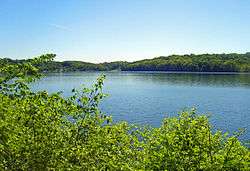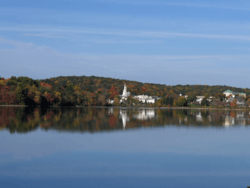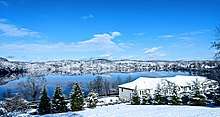Lake Gleneida
Lake Gleneida is a reservoir in the hamlet of Carmel within the Town of Carmel in central Putnam County, New York. Originally a smaller natural water body, Shaw's Pond, it was dammed by New York City in 1870 and enlarged to 168 acres (68 ha) for inclusion in its water supply system.[3] It is classified as a controlled lake by the City system, and is part of its Croton Watershed.
| Lake Gleneida | |
|---|---|
 From east shore, looking south | |
| Location | Carmel Hamlet, New York |
| Coordinates | 41°25′12″N 73°41′00″W |
| Type | reservoir |
| Catchment area | 313.6 acres (126.9 ha)[1] |
| Basin countries | United States |
| Max. length | 3,500 ft (1,100 m) |
| Max. width | 2,000 ft (610 m) |
| Surface area | 168 acres (68 ha)[1] |
| Average depth | 48 ft (15 m)[2] |
| Max. depth | approx. 100 ft (30 m)[2] |
| Water volume | 8,042 acre⋅ft (9,920,000 m3)[1] |
| Surface elevation | 505 ft (154 m) |
| References | [1][2] |
Geography
The roughly heart-shaped lake is immediately to the southwest of downtown Carmel. It is surrounded by grassy parkland sloping down to the lake from the roads on the south and east, and woods on the other sides. NY 301 follows the north shore, ascending to its eastern terminus at NY 52 across from the Putnam County courthouse. Route 52 follows the eastern shore for a short distance to the south of this intersection before it, too, ends at US 6, which continues around the southern shore. There is no road along the western side, although a local street, Glenvue Drive, traverses the top of the 545-foot (166 m)-high ridge there.
The lake fills a small depression in the middle of a hilly area. Its bottom continues its rapid drop from the shoreline, reaching a depth of slightly over 100 feet (30 m) in the middle of the lake, equivalent to the surface of a swampy depression to its east. Mean depth is 48 feet (15 m).[2] It typically contains 8.042 acre feet (9,920 m3), or 2.6 billion US gallons (9,800,000 m3) of water.[1]
There are no inlet brooks. A dam and spillway are located on its northwest end, with outflow draining into the New York City water supply system's West Branch Reservoir, where it joins with waters from the Delaware Aqueduct. Water in excess of New York City's needs there goes over its spillway and into the West Branch Croton River, which is captured downstream by the Croton Falls Reservoir.
History

The lake was originally known as Shaw's Pond, after an early landowner. It had been a part of the Carmel landscape since the hamlet's designation as county seat upon Putnam's 1814 creation. It quickly became a popular spot for boating and fishing.
The name started appearing on maps around 1840. Not long after, residents became dissatisfied with the name and proposed grander names for it. In 1852, a committee of local residents finally settled on Lake Gleneida.[4] New York City bought rights to the lake around 1895 and tore down what houses were built near it.[5]
Recreation
The New York City Department of Environmental Protection (DEP) owns Lake Gleneida, considered one of three controlled lakes in the city's water system. That means it may withdraw water as a right of ownership.[6][7]

Recreational use of the lake falls under DEP regulations. Fishing, ice fishing and boating are allowed with a valid DEP permit and New York State Department of Environmental Conservation-issued fishing license. Swimming is not permitted.
Boats used in the lake may not be used in any other body of water, to prevent the spread of zebra mussels. This raised some local concern in 2005, since many were left on shore during the offseason and the town found them unsightly as it prepared to spend $2.3 million to spruce up the hamlet.[3] DEP was able to get most of the owners to relocate them to storage areas out of sight of downtown.
References
- "Lake Gleneida". findlakes.com. Retrieved 2008-08-04.
- "Map/Diagram of Lake Gleneida". activityguidebook.com. Retrieved 2008-08-04.
- Nackman, Barbara Livingston (2001-05-13). "Abundance of boats put damper on $2.3M plan to improve hamlet". The Journal News. carmelresident.org. Archived from the original on 2007-10-09. Retrieved 2008-08-04.
The New York City Department of Environmental Protection is in charge of Lake Gleneida, created in 1870 when the city built a dam to create a controlled lake.
- "DANIEL DREW'S OLD HOME; THE VILLAGE OF CARMEL AND ITS SURROUNDINGS" (PDF). The New York Times. The New York Times Company. 1890-11-08. Retrieved 2008-08-04.
The lake, along which the village lies, was formerly called Shaw's Pond. It was a beautiful lake, and afforded excellent fishing and boating. But there was something wrong about it. Finally the citizens concluded that the trouble lay in the name. A meeting was called and a committee was chosen to select a name which would do justice to this beautiful sheet of water. The committee finally hit upon "Lake Gleneida" and this was at once applied to it.
- "History of Carmel". NY-NJ-CT Botany. 13 April 2003. Retrieved 29 August 2017.
c.1895 -- New York City acquired the water rights of Lake Gleneida. All the buildings along the lakeshore were torn down.
- New York State Department of Health Regulations, Part 128-1.6(a)(20)
- Rules and Regulations for the Protection from Contamination, Degradation and Pollution of the New York City Water Supply and its Sources, Final Regulations, Chapter 18 – New York City, Subchapter A, Section 18-16 – Definitions (20) "Controlled lake means a lake from which the City may withdraw water pursuant to rights acquired by the City or as a right of ownership. The controlled lakes are: Kirk Lake, Lake Gleneida and Lake Gilead".